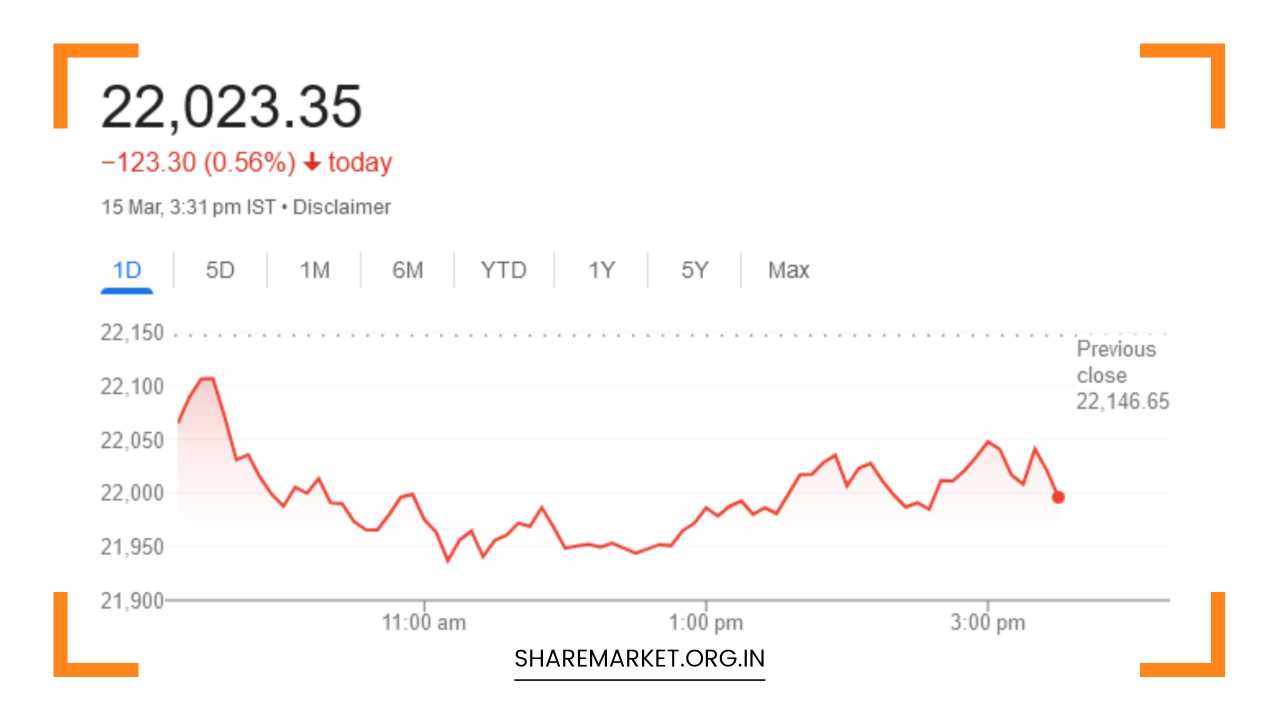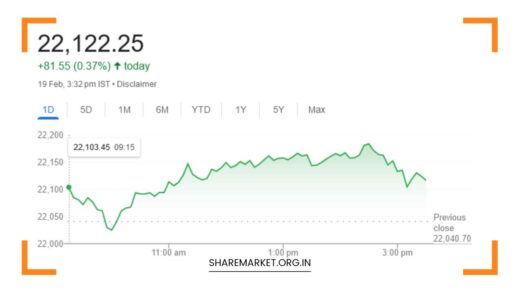Nifty Around 22000; Nifty Prediction for Tomorrow

Nifty Prediction for Tomorrow
Current Market Landscape: A Mixed Bag
The Indian stock market presents a complex picture. While today’s session witnessed a recovery from the previous day’s losses, major indices like Sensex and Nifty closed marginally lower.
This follows a concerning trend: the biggest weekly decline in 5 months, with most sectoral indices (except IT) experiencing setbacks.
Breaking Down the Numbers:
- Headline Indices:
- Sensex: 72,643.43 (-453.85 points, -0.62%)
- Nifty: 22,023.30 (-123.40 points, -0.56%)
- Sectoral Performance:
- Telecom: +1% (lone gainer)
- Oil & Gas, Auto, Capital Goods, Healthcare: -1-2% (significant decline)
- Broader Market:
- Midcap: -0.5%
- Smallcap: Positive movement (indicates some investor interest)
Expert Opinions and Underlying Factors:
Short-Term Concerns:
Rupak Dey (LKP Securities): Highlighting the technical indicators, Dey emphasizes that Nifty falling below the rising trendline weakens market sentiment. He expects a continuation of the downward momentum in the near term, supported by the momentum indicator suggesting a potential recessionary phase. A critical support level exists at 21,900 (50-day moving average). A breach of this level could trigger a sharper decline.
Reasons for the Short-Term Weakness:
Global Cues: Recent weakness in the global market might be impacting domestic investor sentiment.
Profit Booking: After a period of gains, some investors might be taking profits, leading to a temporary pullback.
Opportunities Amidst Challenges:
Vinod Nair (Geojit Financial Services): Nair acknowledges the cautiousness surrounding mid and small caps, attributing the decline to this sentiment.
However, he highlights positive factors like softening commodity prices and an upward revision in India’s FY2025 GDP growth forecast. He anticipates a market rebound after the broader market stabilizes.
Investors are advised to look for fundamentally strong mid and small-cap stocks as potential buying opportunities.
Factors Supporting a Potential Rebound:
Softening Commodity Prices: This could lead to reduced input costs for companies, potentially improving their profitability.
Positive GDP Growth Forecast: An optimistic economic outlook can boost investor confidence and lead to increased market activity.
Navigating the Market:
Kunal Shah (LKP Securities): Focusing on the Bank Nifty index, Shah observes the formation of a “doji” candle, indicating indecisiveness among investors.
He identifies resistance at 47000 (near the 20-day moving average) and support at 46500-46300. A breakout above the resistance level could lead to a move towards 47500, while a breach of the support zone might indicate further decline.
Strategic Considerations for Investors:
Short-Term Investors: Due to the prevailing short-term weakness, exercising caution and implementing effective risk management strategies are crucial. Stop-loss orders and portfolio diversification can help mitigate potential losses.
Long-Term Investors: The current market weakness can present a strategic opportunity for long-term investors. By focusing on fundamentally strong companies with a positive long-term outlook, particularly in sectors expected to benefit from the improving economic climate, investors can potentially benefit from future market recovery.
Beyond Technical Analysis: Broader Economic Landscape
While technical indicators and expert opinions provide valuable insights, a comprehensive understanding of the market environment necessitates considering the broader economic landscape. Factors such as:
Monetary Policy: Decisions by the Reserve Bank of India (RBI) regarding interest rates can significantly impact market liquidity and investor sentiment.
Government Policies: Government initiatives aimed at boosting economic growth and specific sectors can influence market performance.
Global Events: Geopolitical tensions and international economic developments can have a ripple effect on the Indian market.
Continuous Monitoring and Informed Decisions:
Investors should closely monitor these factors alongside expert analysis and market trends. Utilizing reliable financial news sources, attending investor conferences, and consulting with qualified financial advisors can equip individuals with the necessary knowledge to make informed investment decisions.
Disclaimer: This analysis is solely for informational purposes and does not constitute financial advice. Please consult with a qualified financial professional before making any investment decisions.
Additional Insights:
- Focus on Quality: Prioritize companies with strong fundamentals, a proven track record, and a sustainable business model.
- Diversification: Diversify your portfolio across different sectors and asset classes to mitigate risk.
Long-Term Perspective:
Market Fluctuations: The stock market is inherently cyclical, experiencing periods of both growth and decline. A long-term investment approach focuses on weathering these short-term fluctuations and profiting from the overall upward trend of the market over time.
Patience and Discipline: Long-term success requires patience and discipline. Avoiding impulsive decisions driven by short-term market movements is crucial. Sticking to a well-defined investment strategy and maintaining a calm demeanor during periods of volatility is essential.
Behavioral Considerations:
Emotional Investing: Fear and greed are often the biggest enemies of investors. Emotional decision-making can lead to costly mistakes. Investors should strive to remain objective and base their decisions on sound research and analysis.
Fear of Missing Out (FOMO): The urge to invest in hot stocks solely because others are doing so can be detrimental. Chasing trends without proper research can lead to significant losses.
Overconfidence: Investors should be wary of overestimating their knowledge and abilities. Regularly reviewing their investment strategies and seeking professional guidance when necessary is crucial.
Additional Tips for Long-Term Success:
Invest Regularly: A consistent investment approach, such as Systematic Investment Plans (SIPs), can help rupee-cost averaging and benefit from market volatility.
Rebalance Portfolio: Periodically rebalance your portfolio to maintain your desired asset allocation and mitigate risk.
Stay Informed: Continuously educate yourself about the financial markets, economic trends, and investment strategies.
Final Remarks:
The Indian stock market presents a complex scenario with both short-term challenges and long-term potential.
While short-term weakness is predicted due to technical indicators and recent performance, positive long-term factors like an improving economic outlook and potential corporate earnings growth might lead to a market rebound.
Investors, particularly those with a long-term horizon, should:
- Exercise caution in the short term and implement risk management strategies.
- View the current weakness as a potential buying opportunity in fundamentally strong companies.
- Closely monitor the broader economic landscape and incorporate various factors into their investment decisions.
- Maintain a long-term perspective, prioritize quality stocks, and practice patience and discipline.
- Seek professional guidance when necessary.
By following these strategies and remaining informed, investors can navigate the market uncertainties and position themselves to potentially benefit from future growth opportunities.
Disclaimer: This information is for educational purposes only and should not be considered financial advice. Please consult with a qualified financial advisor before making any investment decisions.

















